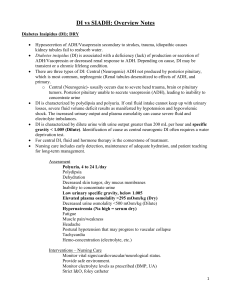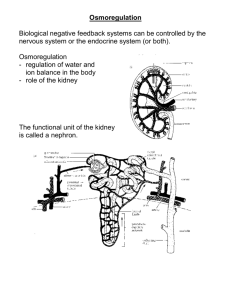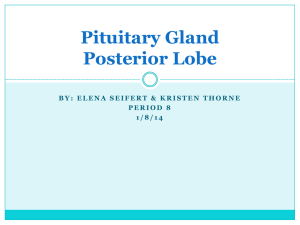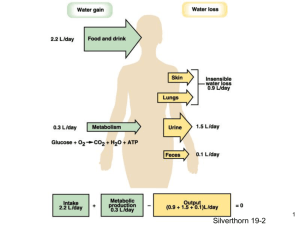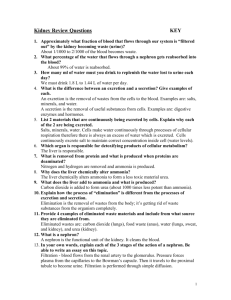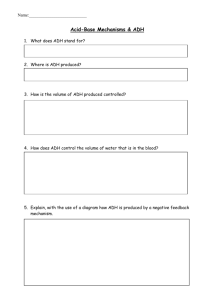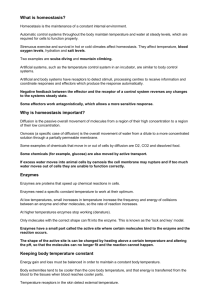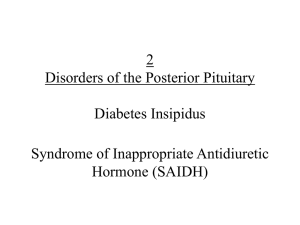SIADH, DI, Cerebral Salt Wasting
advertisement
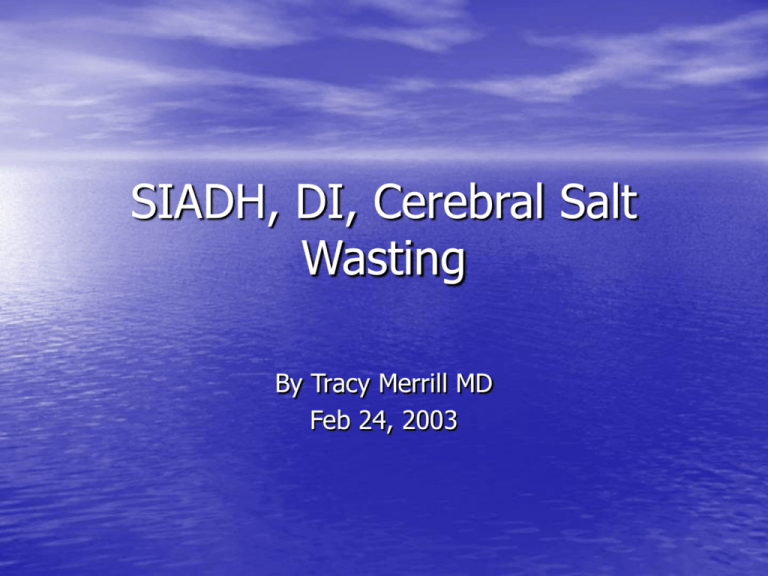
SIADH, DI, Cerebral Salt Wasting By Tracy Merrill MD Feb 24, 2003 SIADH: • = Syndrome of Inappropriate ADH Secretion • Definition: levels of ADH are inappropriately elevated compared to body’s low osmolality, and ADH levels are not suppressed by further decreases in blood osmolality. SIADH: causes • Irritation of CNS: meningitis, encephalitis, brain tumors, brain hemorrhage, hypoxic insult, trauma, brain abscess, Guillain Barre, hydrocephalus • Pulmonary disorders: pneumonia, asthma, positive end expiratory pressure ventilation, CF, TB, pneumothorax SIADH: causes continued • Drugs: vincristine, vinblastine, opiates, carbamazepime, cyclophosphamide • Unregulated tumor production of ADH-like peptides: oat cell lung carcinoma for example, Ewings sarcoma, carcinoma of duodenum, pancreas, thymus SIADH: function of ADH • = antidiuretic hormone = vasopressin • ADH is made in the supra-optic nuclei in the • • • hypothalamus, stored in the posterior pituitary Normally released into the bloodstream when osmo-receptors detect high plasma osmolality At the kidney, attaches to receptors in the collecting ducts, opens up water channels Water is passively reabsorbed along the kidney’s medullary concentration gradient SIADH: signs and symptoms • Decreased/low urine output • Signs of hyponatremia: lethargy, apathy, disorientation, muscle cramps, anorexia, agitation • Signs of water toxicity: nausea, vomiting, personality changes, confused, combative • If Na < 110 mEq/L, seizures, bulbar palsies, hypothermia, stupor, coma SIADH: lab values • Serum Na < 135 (Na is diluted by excessive • • • • free water re-absorption) Serum osmolality low, normal is ~ 270 Urine Na is inappropriately high, >20 mmol/L, actually losing Na in urine instead of retaining it Urine osmolality is inappropriately high, can range b/t 300-1400 mosm/L CVP is high from free water retention SIADH: treatment • Fluid restriction, ¾ maintenance • If symptomatic, may actually need to replace NaCl, can use hypertonic saline for example: 300cc/m2 of 1 ½ % NS • Diuretics such as lasix • Treat underlying disorder, for example usually resolves after removal of lung carcinomas SIADH: treatment cont… • Demeclochlorotetracycline, blocks ADH receptors in the renal collecting ducts • In severe cases, hemodialysis • Warning, if increase Na too fast, at risk for pontine myelinolysis • Max correction of 15mEq in 24 hours DI = Diabetes Insipidus • Definition: inability to effectively conserve • • urinary water Central: ADH not made or not released in the hypothalamic-pituitary axis Nephrogenic: ADH is released but not detected by the receptors in the kidney collecting ducts, often a sex-linked recessive condition, also due to renal pathology, electrolyte disorders, drugs Central DI: causes • Head trauma • Brain neoplasms • Congenital CNS defects • CNS infections • CNS hypoxia • ADH secretion also decreased by certain drugs: EtOh, demerol, MSO4, dilantin, barbiturates, glucocorticoids DI: • Make sure distinguish DI from conditions in • which the presence of non-absorbable, osmotically active solutes in the renal tubules prevent water re-absorption. Example: glucose loss in the urine of diabetics will decrease the tubule- medullary concentration gradient and even though ADH is there, water won’t get passively reabsorbed Central DI: signs/symptoms • Polyuria • Dehydration, may not be readily apparent b/c of hyper-osmolarity, fluid shifts from cells to intravascular spaces and maintains blood pressure, CVP • Weight loss is a better measure of fluid status Central DI: Lab values • Hypernatremia, Na >150-160 • High serum osmolality (normal 270) • Urine Na < 20 mmol/L • Low urine osmolality (very dilute urine) Central DI: treatment • Increase po or IV free H20 consumption, use hypotonic saline • Volume replacement cc for cc • Vasopressin/ ADH administration (bolus or drip 1.5-2.5 mU/kg/hr) • Of course, treat underlying cause Cerebral Salt Wasting • Causes: CNS damage – Closed head injury – CNS surgery – CNS tumors – CNS infections, meningitis Cerebral Salt Wasting • Signs/symptoms: – Polyuria – Wt loss – Dehydration/hypovolemia – Hypotension – Low CVP Cerebral Salt Wasting • Lab values: – Hyponatremia due to excessive renal Na loss – High urine Na, > 20 mmol/L – Increased plasma ANP, atrial natriuretic peptide, b/c of low volume status – Inappropriately normal or low aldosterone and ADH levels despite high ANP Cerebral Salt Wasting • Treatment: – Volume for volume replacement of urine Na losses – When dc’d from hospital, most will still need oral Na supplementation for a period of time DI SIADH CSW Urine Output polyuric decreased polyuric Serum Na high low low Urine Na low high high Serum osm high low Can be low or normal Urine osm low high Can be low or normal CVP Can be normal or low high low

